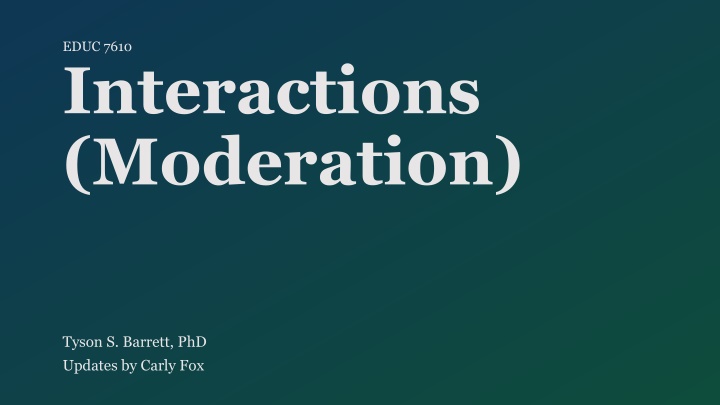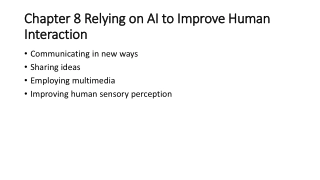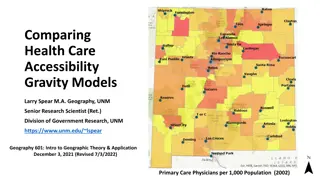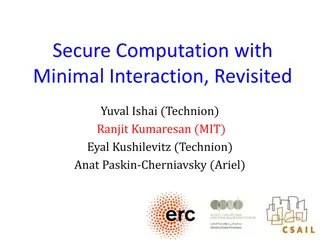Interaction in Research
In research, interaction refers to the relationship between a predictor and outcome that depends on another variable. This interaction can be symmetric, involving different variables as predictor and moderator. Types of interactions include two-way interactions between numeric, dichotomous, and multi-categorical variables. The interpretation of coefficients in interactions remains consistent across different types. Examples illustrate how treatment effects may vary based on participant characteristics.
Download Presentation

Please find below an Image/Link to download the presentation.
The content on the website is provided AS IS for your information and personal use only. It may not be sold, licensed, or shared on other websites without obtaining consent from the author.If you encounter any issues during the download, it is possible that the publisher has removed the file from their server.
You are allowed to download the files provided on this website for personal or commercial use, subject to the condition that they are used lawfully. All files are the property of their respective owners.
The content on the website is provided AS IS for your information and personal use only. It may not be sold, licensed, or shared on other websites without obtaining consent from the author.
E N D
Presentation Transcript
EDUC 7610 Interactions (Moderation) Tyson S. Barrett, PhD Updates by Carly Fox
What is meant by interaction? 6 When the relationship between a predictor and the outcome depends on another variable 4 x2_cat 0 2 y Also called moderation When called moderation, one of the variables is called the moderator 1 0 2 0.00 0.25 0.50 x1 0.75 1.00 This is an example of an interaction between a continuous predictor and a dichotomous moderator
The Symmetry of Interaction 40 Either variable can be considered the predictor and the moderator 30 x2 1 2 Usually depends on the research question/story to be told The interpretation still means the same thing but can sound very different 20 3 y 4 5 6 10 0 2 4 6 x1
The Symmetry of Interaction 40 40 Either variable can be considered the predictor and the moderator 30 30 x2 x1 1 1 2 2 Usually depends on the research question/story to be told The interpretation still means the same thing but can sound very different x2 20 20 3 3 y y 4 4 5 5 6 6 10 10 0 0 2 4 6 2 4 6 x1 Same interaction, different predictor/moderator distinction
Types of Interactions Two-way interactions can be between: Two numeric variables A dichotomous variable and a numeric variable Two dichotomous variables A multi-categorical variable and a numeric variable Two multi-categorical variables
Types of Interactions Two-way interactions can be between: Two numeric variables Examples The effect of the treatment on the outcome may depend on the sex of the participant The effect of smoking on heart condition may depend on age The effect of education on income may depend on the economic climate A dichotomous variable and a numeric variable Two dichotomous variables A multi-categorical variable and a numeric variable Could we reverse the way that we said each of these? Yes Two multi-categorical variables
General interpretation of coefficients Doesn t matter if they are numeric or categorical ? = 2 + 0.5 ?1+ 2 ?2+ 1.5 ?1?2
General interpretation of coefficients Doesn t matter if they are numeric or categorical When X2 is zero: ? = 2 + 0.5 ?1+ 2 ?2+ 1.5 ?1?2 Meaning when X2 is zero, the effect of a one unit increase in X1 is associated with a 0.5 unit increase in Y
General interpretation of coefficients Doesn t matter if they are numeric or categorical When X1 is zero: ? = 2 + 0.5 ?1+ 2 ?2+ 1.5 ?1?2 Meaning when X1 is zero, the effect of a one-unit increase in X2 is associated with a 2 unit increase in Y
General interpretation of coefficients Doesn t matter if they are numeric or categorical The difference in the slopes is 1.5 on average 90 x2 1 ? = 2 + 0.5 ?1+ 2 ?2+ 1.5 ?1?2 2 60 3 y 4 5 6 30 All of these interpretations can be with additional covariates, holding the covariates constant 0 0.0 2.5 5.0 x1 7.5 10.0
General interpretation of coefficients Doesn t matter if they are numeric or categorical The total effect of X1 is: ? = 2 + 0.5 ?1+ 2 ?2+ 1.5 ?1?2 ? = (0.5 + 1.5 ?2)?1 Effect of ?1= 0.5 + 1.5 ?2
General interpretation of coefficients Doesn t matter if they are numeric or categorical The total effect of X1 is: The same idea holds for the effect of X2 ? = 2 + 0.5 ?1+ 2 ?2+ 1.5 ?1?2 ? = (0.5 + 1.5 ?2)?1 Effect of ?1= 0.5 + 1.5 ?2 Effect of ?2= 2 + 1.5 ?1
A General Example: Numeric (?1) with Dichotomous (?1) ? = 2 + 0.5 ?1+ 2 ?1+ 1.5 ?1?1 The conditional effect of D1 when X1 equals zero Cross-product (interaction) The intercept (the average Y value when all variables are zero) quantifies how much the conditional effect of X1 changes as D1 changes by one unit The conditional effect of X1 when D1 equals zero
A General Example: Numeric with Dichotomous The conditional effect of D1 when X1 equals zero quantifies how much the conditional effect of X1 changes as D1 changes by one unit The intercept (the average Y value when all variables are zero) The conditional effect of X1 when D1 equals zero Cross-product (interaction)
Interaction between two numeric variables ? = 2 + 0.5 ?1+ 2 ?2+ 1.5 ?1?2 The conditional effect of X2 when X1 equals zero Cross-product (interaction) The intercept (the average Y value when all variables are zero) quantifies how much the conditional effect of X1 changes as X2 changes by one unit The conditional effect of X1 when X2 equals zero
Interaction between two dichotomous variables ? = 2 + 0.5 ?1+ 2 ?2+ 1.5 ?1?2 The conditional effect of D2 when D1 equals zero Cross-product (interaction) The intercept (the average Y value when all variables are zero) quantifies how much the conditional effect of D1 changes as D2 changes by one unit The conditional effect of D1 when D2 equals zero
6 When we visualize an interaction with two numeric variable, we need to group one of them into some groups to 4 x2_cut [0.021,0.347] 2 y (0.347,0.673] (0.673,1] better see it 0 6 2 0.00 0.25 0.50 x1 0.75 1.00 4 x2_cat 0 2 y 1 With a numeric variable and a dichotomous variable, we use the dichotomous as the grouping variable 0 2 0.00 0.25 0.50 x1 0.75 1.00
When we visualize an interaction with a numeric variable and multi-categorical, we can use the multi-cat variable as the grouping 10.0 7.5 x2_cat Group 1 y Group 2 variable Group 3 5.0 4 2.5 3 0.0 x2_cat 0.00 0.25 0.50 x1 0.75 1.00 0 y 2 1 With two dichotomous variables, we can use either dummy variable as the grouping variable 1 0 0 1 factor(x1)
Lets Try an Example You ve been doing more binge-watching on Netflix and decide to analyze a dataset based on your new favorite show: Married at First Sight You decide to examine whether the length of these reality TV couples relationships (outcome) can be predicted by their age gap (predictor), and whether this effect is moderatedby which Love Expert the couple worked with most often on the show Here we have a numerical variable predictor and dichotomous moderator
You run the interaction in R and get the Following Results lm(Relation_length ~ Gap * Expert, data = Mafs) Coefficients (Intercept) Gap Expert_Pepper Gap:Expert_Pepper -4.201 Estimate 10.565 2.864 15.222 Std. Error t value 1.903 0.437 2.554 0.579 Pr(>|t|) 5.80e-07*** 1.11e-08*** 1.17e-07*** 6.77e-10*** 5.554 6.555 5.964 -7.250 Next we plot the interaction to visualize the relationship
Just from inspecting the graph, we can see a clear interaction where the relationship b/w age gap and length of couples relationships appears to be impacted by which love expert they worked with
Interpretation Intercept: When couples work with Dr. Coles and have 0 years of age gap, their expected relationship duration is 10.56 months Gap: For each one year increase in age gap, there is an associated 2.86 month increase in relationship duration for couples who work with Dr. Coles Expert_Pepper: When there is no age gap and couples work with Dr. Pepper, the expected relationship duration is 15.22 monthshigher than with Dr. Coles Interaction: The effect of age gap on the length of couples relationships decreases by 4.20 months when couples work with Dr. Pepper compared to when they work with Dr. Coles In other words, age gap has differential associations with the length of couples relationships, depending on which Love Expert they worked with on the show
More about interpretation To make b1 and b2 more meaningful, we can shift the center of the predictor/moderator E.g., we can mean center the variables which makes b1 and b2 the effect of the predictor/moderator when the other is at its mean This is the conditional effect of the variable at the other variable s mean The conditional effect means the effect conditional on the other variable being a certain value
Difference between Regression and ANOVA There are several similarities (and ultimately are the same) with some minor differences Regression ANOVA
Difference between Regression and ANOVA There are several similarities (and ultimately are the same) with some minor differences Regression ANOVA Dummy Coding Effect Coding
Probing an Interaction Lots of info, what to focus on? Lots of information we can glean from a model with an interaction But much of it relies on p-values and can get excessive Almost always, a figure can highlight all the important factors more easily, simply, and clearly A figure with some specific details is usually the best way to interpret it When you have two numeric variables interacting, using the Johnson-Neyman approach is great
More about Conditional Effects Numeric Dichotomous Multi-Categorical We can center a variable around any value and test if the conditional effect is different than zero We can switch the reference group by centering it with -1 (if coded 0 and 1) Like dichotomous, we can switch the reference group by subtracting the value of the group (for group = 2 use -2) E.g., what is the effect of age on heart disease when the person is a smoker? What about if they aren t? E.g., what is the effect of liberal views on voting behavior when the individual is black? Asian- American? E.g., what is the effect of hearing loss on income when age is 20? How about 40? 60? Johnson-Neyman Technique does this many times looking for areas of significant differences and non-significant ones (for numeric interactions) https://cran.r-project.org/web/packages/interactions/vignettes/interactions.html#simple_slopes_analysis_and_johnson-neyman_intervals
Issues with Detecting/Interpreting an Interaction Interactions are difficult to accurately detect It is low powered Easier to detect in experiments Is it curvilinear or interacting? Transformations of Y can greatly impact an interaction No main effects in model like in ANOVA Myths Get Busted (i.e., the truth is stated below): Don t need to mean-center predictors in interaction Don t need to build model hierarchically Don t need to categorize variables in interaction
Read More Here! Interpreting Interaction Effects: https://www.theanalysisfactor.com/interpreting-interactions-in- regression/ Interactions between Categorical and Continuous Variables: https://www.theanalysisfactor.com/interactions-categorical-and- continuous-variables/ Simple Slopes Analysis and Johnson Neyman Intervals in R: https://cran.r- project.org/web/packages/interactions/vignettes/interactions.html#si mple_slopes_analysis_and_johnson-neyman_intervals
Dont fall for all their tricks!























